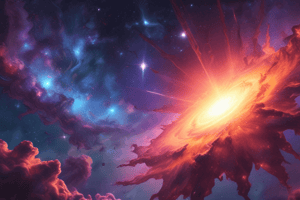Podcast
Questions and Answers
What is the name of the theory that proposes planets form from a spinning disk?
What is the name of the theory that proposes planets form from a spinning disk?
- Nebular Theory (correct)
- Angular Momentum Theory
- Solar System Formation Theory
- Nebular Contraction
What is the main force that causes the nebula to contract?
What is the main force that causes the nebula to contract?
- Electromagnetic forces
- Angular momentum
- Centrifugal forces
- Gravity (correct)
What is the shape of the nebula after it has shrunk to about 100 A.U.?
What is the shape of the nebula after it has shrunk to about 100 A.U.?
- Pancake-shaped (correct)
- Elliptical
- Cylindrical
- Spherical
What is the result of the increase in rotation speed as the nebula contracts?
What is the result of the increase in rotation speed as the nebula contracts?
Who showed mathematically that conservation of angular momentum demands that the nebula must spin faster as it contracts?
Who showed mathematically that conservation of angular momentum demands that the nebula must spin faster as it contracts?
What is the name of the star that is about 50 light-years from the Sun and has a visible-light image of a disk surrounding it?
What is the name of the star that is about 50 light-years from the Sun and has a visible-light image of a disk surrounding it?
What is the result of the conservation of angular momentum on the nebula's shape?
What is the result of the conservation of angular momentum on the nebula's shape?
What is the name of the cloud of interstellar dust and gas that forms the solar system?
What is the name of the cloud of interstellar dust and gas that forms the solar system?
What is the approximate diameter of the disk of warm matter observed around Beta Pictoris?
What is the approximate diameter of the disk of warm matter observed around Beta Pictoris?
What is the estimated age of the star Beta Pictoris?
What is the estimated age of the star Beta Pictoris?
What was the main issue with Laplace's description of the solar nebula?
What was the main issue with Laplace's description of the solar nebula?
What is the main prediction of computer calculations regarding the formation of clumps in a disk of gas?
What is the main prediction of computer calculations regarding the formation of clumps in a disk of gas?
What is the name of the currently favored model of planetary formation?
What is the name of the currently favored model of planetary formation?
What is the main advantage of the condensation theory over the old nebular theory?
What is the main advantage of the condensation theory over the old nebular theory?
Flashcards are hidden until you start studying
Study Notes
Nebular Contraction and Star Formation
- A large cloud of interstellar dust and gas, called a nebula, contracts under its own gravity due to external influences such as a collision with another interstellar cloud or a nearby star explosion.
- As the nebula contracts, it becomes denser and hotter, eventually forming a star at its center.
Nebular Theory by Pierre Simon de Laplace
- In 1796, Pierre Simon de Laplace showed that conservation of angular momentum demands that the nebula must spin faster as it contracts.
- The increase in rotation speed causes the nebula's shape to change as it shrinks, with centrifugal forces opposing the contraction in directions perpendicular to the rotation axis.
- As a result, the nebula collapses most rapidly along the rotation axis, flattening into a pancake-shaped disk.
Solar Nebula and Planetary Formation
- The swirling mass destined to become our solar system is referred to as the solar nebula.
- The planets form out of this spinning disk, explaining the origin of the architecture observed in our planetary system today, such as:
- Near-circularity of the planets' orbits
- Prograde orbits in almost the same plane
Observational Evidence
- Similar disks have been observed (or inferred) around other stars, such as Beta Pictoris.
- The disk around Beta Pictoris is roughly 1000 A.U. across, about 10 times the diameter of Pluto's orbit.
- Astronomers believe that Beta Pictoris is a very young star, perhaps only 100 million years old, and that we are witnessing its passage through an evolutionary stage similar to that experienced by our own Sun 4.6 billion years ago.
Limitations and Evolution of the Theory
- Laplace's description of the collapse and flattening of the solar nebula was essentially correct, but a disk of gas would not form clumps of matter that would subsequently evolve into planets.
- Computer calculations predict that any clumps in the gas would tend to disperse, not contract further.
- The currently favored model, the condensation theory, rests on the old nebular theory, combining its basic physical reasoning with new information about interstellar chemistry to avoid most of the original theory's problems.
Studying That Suits You
Use AI to generate personalized quizzes and flashcards to suit your learning preferences.




